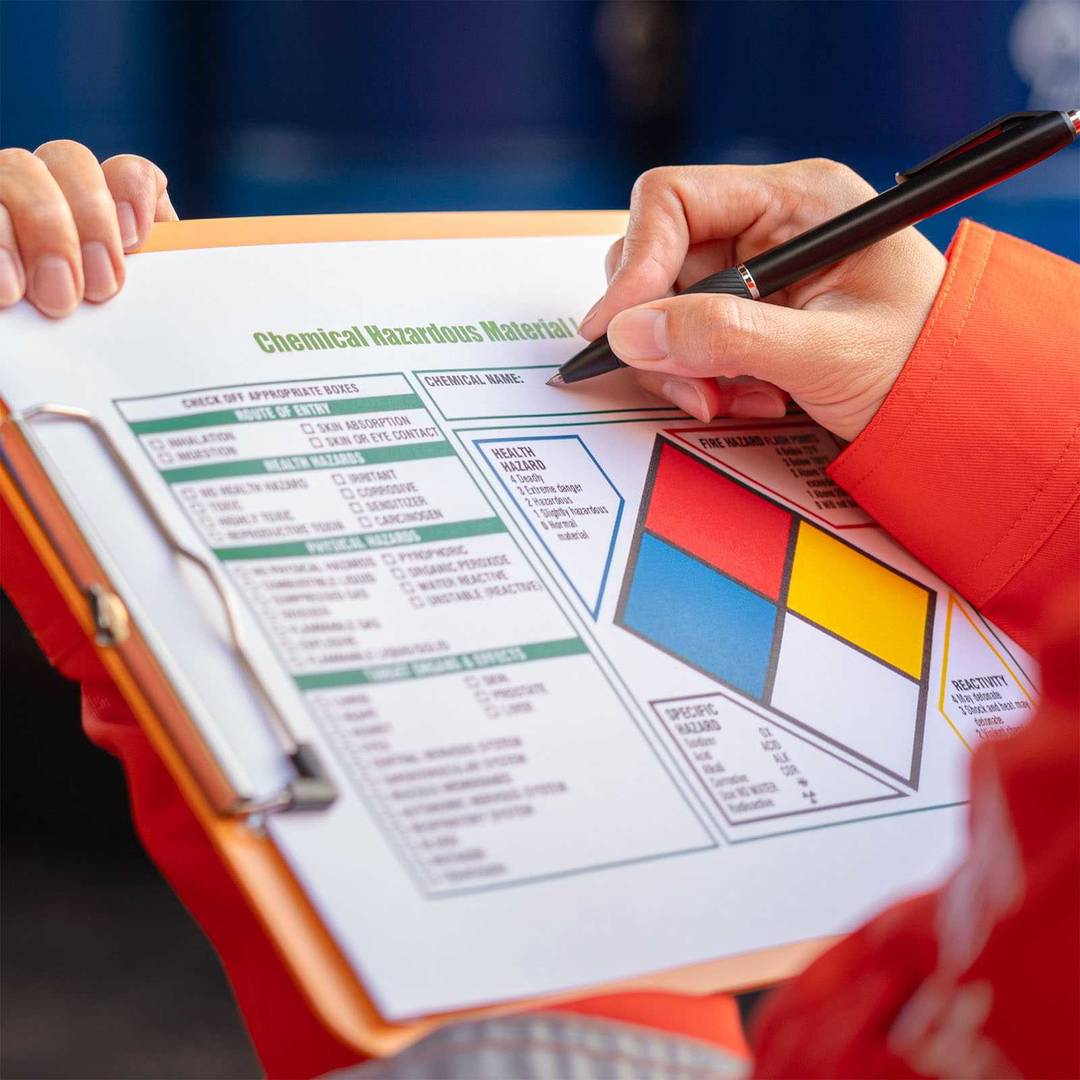EnviroMail 34 USA
Streamlining Hazardous Waste Classification with Faster Test Report Analysis
Accurate waste classification ensures environmental consulting clients stay compliant and manage costs effectively.

ALS provides a clear and concise overview of waste classification principles, helping to navigate test reports, assign accurate codes, and ensure safe waste management practices.
Contents:
What is Waste Classification?
Waste classification is the process of identifying whether a waste stream is hazardous or non-hazardous by evaluating its physical and chemical properties against regulatory thresholds.
Proper classification determines how waste is stored, transported, treated, and disposed of under federal and state guidelines.
Why do Consultants Need to Classify Waste?
Consultants classify waste to ensure proper management and compliance with legal standards. This process serves several purposes:
- Compliance: EPA regulations like the Resource Conservation and Recovery Act (RCRA) and state regulations mandate proper waste classification for responsible waste management.
- Cost-Effectiveness: Misclassification can lead to hefty fines or unnecessary disposal costs. For example, disposing of non-hazardous waste as hazardous incurs significantly higher fees.
- Safety: Proper classification ensures the safety of personnel handling, transporting, and disposing of the waste. Hazardous wastes require specific protocols to minimize risks of exposure and environmental contamination.
- Environmental Stewardship: Ensures waste streams are managed in a way that minimizes harm to ecosystems and public health.
What Role Does Testing Play in Waste Classification?
Testing is the foundation of waste classification, transforming raw samples into actionable data that guides decision-making. It determines whether waste is:
- Characteristic Hazardous Waste: Tests identify if waste is ignitable, corrosive, reactive, or toxic (e.g., through flash point, pH, or the Toxicity Characteristic Leaching Procedure [TCLP] suite of analyses).
- Listed Hazardous Waste: Testing confirms if regulated substances from federal hazardous waste lists are present above actionable thresholds.
- Toxic: The TCLP leaching procedure simulates landfill leaching to evaluate contamination potential, classifying waste as hazardous if toxins like lead or mercury exceed limits.
- State-Specific Metrics: Some analytes, such as fluoride and chloride, are regulated more strictly in certain states.
How to Read Test Results
Lab reports can be overwhelming at first glance, but they follow a consistent structure that can guide waste classification when paired with a classification table. Here's how to break it down and connect the results to the appropriate waste category:
- Start with the Results Table: The results table lists analytes tested, their concentrations, and any qualifiers. Focus on the analyte column to identify substances tested, then check adjacent columns for their concentrations and qualifiers.
- Connect Results to Waste Categories:
- Characteristic Hazardous Waste: Look for data on properties like flash point (ignitability) or pH (corrosivity). Reactivity and toxicity results may appear separately.
- Listed Hazardous Waste: Match analyte names to substances in federal lists, such as solvents, pesticides, or industrial by-products.
- Toxicity (TCLP): Review TCLP results to see if analytes leach toxic levels of regulated substances.
- State-Specific Metrics: Look for additional analytes (e.g., fluoride, nitrate) listed under state-specific sections for nonhazardous classifications.
- Align Report Sections with the Classification Table: Cross-reference results with the classification table to match outcomes with waste categories.
- Review the Case Narrative: The case narrative explains deviations, interferences, or flagged results, which are key for interpreting unusual outcomes or qualifiers.
How to Use Test Results to Classify Waste
Using test results effectively requires aligning the data from your lab report with the classification table provided below. Keep in mind that state regulations may introduce additional requirements or stricter thresholds, so always cross-check with local guidelines.
The table below provides a quick reference to identify waste categories based on analytes, thresholds and assign the corresponding waste codes. Keep in mind that state regulations may introduce additional requirements or stricter thresholds, so always cross-check with local guidelines.
| Analyte Type | Analyte/Category | Threshold/Criteria | Classification |
|---|---|---|---|
| Physical Characteristics | Ignitability | Flash Point <140°F | Hazardous Waste (D001) |
| pH (Corrosivity) | ≤ 2 or ≥ 12.5 | Hazardous Waste (D002) | |
| Reactivity(Explosives, Gases) | Reacts violently, unstable, or generates toxic gases | Hazardous Waste (D003) | |
| Inorganics | Reactive Cyanide, Reactive Sulfide | ≥ 250 mg/L | Hazardous Waste (D003 if reactive; otherwise regulated) |
| Nitrate, Fluoride, Chloride | State-specific thresholds | Nonhazardous Waste (Class 1 for significant toxicity) | |
| Metals (RCRA 8) | Arsenic | ≥ 5.0 mg/L (TCLP) | Hazardous Waste (D004) |
| Barium | ≥ 100 mg/L (TCLP) | Hazardous Waste (D005) | |
| Cadmium | ≥ 1.0 mg/L (TCLP) | Hazardous Waste (D006) | |
| Chromium | ≥ 5.0 mg/L (TCLP) | Hazardous Waste (D007) | |
| Lead | ≥ 5.0 mg/L (TCLP) | Hazardous Waste (D008) | |
| Mercury | ≥ 0.2 mg/L (TCLP) | Hazardous Waste (D009) | |
| Selenium | ≥ 1.0 mg/L (TCLP) | Hazardous Waste (D010) | |
| Silver | ≥ 5.0 mg/L (TCLP) | Hazardous Waste (D011) | |
| Non-RCRA Metals (e.g., zinc) | State-specific thresholds | Nonhazardous Waste (Class 1, 2, or 3 based on limits) | |
| Volatile Organic Compounds (VOCs) | Benzene | ≥ 0.5 mg/L (TCLP) | Hazardous Waste (D018) |
| Trichloroethylene (TCE) | ≥ 0.5 mg/L (TCLP) | Hazardous Waste (D040) | |
| Vinyl Chloride | ≥ 0.2 mg/L (TCLP) | Hazardous Waste (D043) | |
| Additional VOCs (e.g., toluene) | State-specific thresholds | Nonhazardous Waste or Class 1 (if toxic) | |
| Semi-Volatile Organic Compounds (SVOCs) | 2,4-Dinitrotoluene | ≥ 0.13 mg/L(TCLP) | Hazardous Waste (D030) |
| Pentachlorophenol | ≥ 100 mg/L (TCLP) | Hazardous Waste (D037) | |
| Phenol | ≥ 1.0 mg/L(state-specific limits for non-hazardous) | Nonhazardous Waste or Class 1 | |
| Other SVOCs | Refer to EPA TCLP Limits: 40 CFR 261.24 | Hazardous Waste (if exceeds TCLP limits) | |
| Other Listed Wastes | “F” Listed Wastes | Wastes from nonspecific sources (e.g., spent solvents, degreasers, and electroplating baths). See Section 261.31. | Hazardous Waste (EPA F-Code) |
| “K” Listed Wastes | Wastes from specific industries(e.g., petroleum refining, wood preservation, or pesticide manufacturing).See Section 261.32. | Hazardous Waste (EPA K-Code) | |
| “P” Listed Wastes | Acutely hazardous unused off-specification chemicals and their residues. See Section 261.33. | Hazardous Waste (EPA P-Code) | |
| “U” Listed Wastes | Toxic unused off-specification chemicals and their residues. See Section 261.33. | Hazardous Waste (EPA U-Code) | |
| Petroleum Hydrocarbons | Total Petroleum Hydrocarbons (TPH), Oil & Grease | ≥ 1,000–1,500mg/L (state-defined thresholds) |
Nonhazardous Waste (Class 1 or state-regulated equivalent) |
| Polychlorinated Biphenyls (PCBs) | PCBs | ≥ 50 ppm (regulated under TSCA--see 40 CFR Part 761) |
TSCA-Regulated Waste (Hazardous or Class 1 depending on state rules) |
| Pesticides/Herbicides | General Pesticides (e.g., Endrin, Lindane, Methoxychlor) | Refer to EPA TCLP Limits: 40 CFR 261.24 | Hazardous Waste (if exceeds TCLP limits) |
| Asbestos | Regulated Asbestos (RACM) | Meets federal/state RACM definitions | Nonhazardous Waste (Class 1, state-specific disposal requirements) |
| Pharmaceutical Waste | Listed Hazardous Pharmaceutical Ingredients | Check specific drug formulations per EPA: Hazardous Drugs | Hazardous Waste if listed or exceeds toxicity/reactivity thresholds |
| Universal Wastes | Batteries, Mercury-Containing Equipment, Lamps | Refer to EPA Universal Waste Program: 40 CFR Part 273 | Nonhazardous Universal Waste (must be managed under universal waste rules) |
National vs. State Regulations and Classifications
While the Resource Conservation and Recovery Act (RCRA) provides a national framework for hazardous waste, states often have their own specific regulations that may be stricter or more comprehensive.
- RCRA Hazardous Waste Characteristics: Ignitability, corrosivity, reactivity, and toxicity are the primary criteria for hazardous waste classification under RCRA.
- RCRA Listed Wastes: RCRA identifies specific waste streams as hazardous based on their composition or origin.
- State-Specific Regulations: States may impose additional criteria, such as specific chemical parameters or stricter thresholds for hazardous waste characteristics.
- State-Specific Listed Wastes: States may have their own lists of hazardous and non-hazardous wastes.
To ensure compliance, consultants should:
- Cross-reference test results with both federal and state regulations.
- Stay updated on evolving regulations.
- Consult with state regulatory agencies for clarification.
- Utilize state-specific resources for guidance.
Helpful Links
- EPA Hazardous Waste Classification: EPA RCRA Resource
- EPA State Environmental Agencies Directory: Use this directory to locate state-specific environmental resources and regulations for waste classification.
- Many states have their own guides, such as:
- California’s DTSC hazardous waste criteria
- Texas’s TCEQ RG-022 framework
Choose ALS
ALS supports environmental consultants by providing the accurate and detailed testing data essential for waste classification.
Our services are designed to align seamlessly with the principles outlined in this article, helping you confidently navigate complex regulatory landscapes.
- Comprehensive Testing Services: We provide precise analysis across all waste matrices, including physical characteristics, inorganics, organics, and state-specific metrics, ensuring compliance with federal and state regulations.
- Actionable Reporting: Our clear and concise lab reports are structured to simplify classification decisions, with data directly aligned to regulatory thresholds and waste categories.
- Regulatory Expertise: ALS offers expert guidance to interpret test results, cross-reference them with EPA RCRA standards, and incorporate state-specific requirements to ensure accurate classifications and compliance.
- Cost-Effective Solutions: With precise testing and classification, ALS minimizes the risks of misclassification, helping you avoid unnecessary costs or potential penalties.
By partnering with ALS, consultants gain a trusted resource for managing waste classification, ensuring projects are compliant, efficient, and environmentally responsible. Let ALS empower your efforts to balance compliance, cost-effectiveness, safety, and stewardship.
Contact ALS today to learn more about test methods available for your waste compliance projects.




























